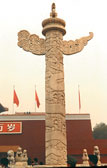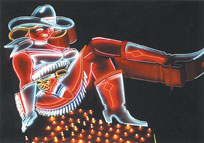Early
in the AIDS epidemic Lakich recognized the horror of ignorance and neglect
on the part of the nation's public health policies which led to the martyrdom
of thousands before the existence of the crisis was acknowledged. In three
works from this series included in the exhibition, Lakich begins with a half-figure
matrix, rib lines highlighted on each side, bent arms placed in back of a
large glass lens head. While neon back lights each work and is ethereally
incorporated on the surfaces, it is found-object assemblage which distinguishes
each piece: an amethyst geode in For all
the Young Men Dying (1988); a buffalo skull in Flesh
and Blood so Cheap (1989); and Cadillac tail lights in
Sacred Heart (1991).
In the latter she attaches a verbal cue, “Vacancy,” to spell out
the void left in private lives and the public sphere by the loss of so many
lives. Lakich is active in the fight against AIDS in her alternate career
in marketing identity and environmental design as well, designing signage
and publications for AIDS Healthcare Foundation and its Out of the Closet
stores.
Diametrically opposite in scale, style and message
from the somber and tragic images of the AIDS series is the monumental Mardi
Gras (1989), commissioned for the corporate lobby of
Unity Savings.2 This fanciful sculpture abounds with
whimsy and merriment, much like Juan Miro's imaginary playgrounds of biomorphic
shapes and animated lines. This work perhaps most captures the magic and appeal
of the large neon signs of Las Vegas and Broadway in their heyday.
Stele for Unknown
(1989) was done the same year as Mardi Gras
and is intriguing in its much sharper and critical tone. Exaggerating the
vertical format of historical steles, and reinterpreting a winged memorial
column near the Forbidden City in Beijing, Lakich creates a totemic sculpture
with a winged skull (a variation of a colonial New England gravestone, also
seen in Blessed Oblivion),
a hand, and a few additional neon lines. The word “Unknown” signals
the dilemma of people who do not seek to distinguish themselves in life and
who therefore are not remembered.
These works, the “Other Neon Seductions”
of the exhibition title, indicate the artist’s evolution from sophisticated
and elegant works with strong neon components, to works with growing emphasis
on, and experimentation with, the other materials of her sculpture. Her latest
sculptures, rawer in conception, and more industrial in appearance, are the
primary focus of the keynote work of the exhibition, Sirens,
an installation created in 2001.
Lakich’s earlier artworks engage the traditional,
museum interpretation of installation—that is, the arrangement within
the exhibition space of individual works so that each piece sustains its significance
while the exhibition as a whole makes a cohesive statement. In contrast, Sirens
embodies the current interpretation of installation as genre, an artist's
creation of an entire tableau or environment as a single esthetic statement.
While Director of MONA, Lakich oversaw numerous installations in the traditional
museum sense. It is only in this exhibition that she creates her first artwork
in the installation genre.
Throughout the twentieth century artists have been
pushing the boundaries of visual arts to introduce more time-space elements,
establishing what some have interpreted as an inexorable move towards theater.
Futurists, Constructivists, Surrealists, and members of the Bauhaus experimented
with various formats for space-time creations. At mid-century activities in
the Pop Art and Fluxus movements continued these efforts to deconstruct and
reconstruct traditional confines of the visual arts. Continued enquiry in
the later part of the century produced crossbred forms such as environmental,
earth, and site-specific art, both within and beyond the confines of museum
walls.3 As in these precursors, today’s installation
art fuels the impulse to subvert the context of a given space, permanence
in art, and the autonomy of individual media.4
Sirens
is a site-specific bar, a generic watering hole, re-situated from a Southern
California suburban desert, perhaps somewhere in the San Fernando Valley,
to its temporary home at the CSUN Galleries. The bar’s seven-foot sign
on the exterior wall is a seductive mermaid in glowing multi-colored neon,
a beacon in the isolation of the night. It is reminiscent of advertising signs
popular in the fifties and sixties and admired by Lakich in her family’s
frequent cross-country travels. The sign also reflects the ubiquitous popularity
of a mermaid as siren, evident in a Mexican playing card. She is the femme
fatale seen at the end of the nineteenth century in the posters of Alphonse
Mucha, Henri deToulouse-Lautrec and Dudley Hardy, luring prospective patrons
from the sidewalks and streets to the entertainment offered within. Inside
the bar, one is mesmerized by the luminosity of the commercial beer signs
and clocks (these were the first mass-produced neon signs) and by the coterie
of archetypal bar habitués, lonely yet hopeful in their quest for companionship.
As the visual narrative unfolds, mixing the familiar with the unknown, this
escapist oasis becomes an allegorical tableau of the perennial concerns of
its occupants. Sirens
might recall a more somber tableau, Barney's Beanery, a 1965 assemblage
by Edward Kienholz;5 however, figures in Lakich’s
work are interactive, invite viewer participation, and suggest some social
exchange.
Upon entering the bar, the guest sees familiar staples
such as a pool table with overhead light; beer, cigarette and other advertising
signs; barstools and tables, and even a beaded curtain. Intermingled with
these ready-mades are assemblage characters, all of which are composed of
found objects, metal, and neon accents.
Call Me: A Self
Portrait invites the visitor to touch her payphone torso,
activating Blondie's song of the same name, reincarnated as a siren's call;
another bar staple, the tabletop jukebox, serves as her head. Lakich interjects
herself into this tableau, discarding the artist-as-observer role, and even
insists on the autobiographical by including her actual phone number on the
torso. Don't Ask/Don’t Tell
(a more ominous siren call, a soldier's alert to the nation’s recent
policy towards gay members of the Armed Forces), wears military epaulets,
a propeller insignia, and large wood printer's typeset voicing the visual
quandary his/her body projects. Girly Girl
is the bar flirt, enticing with her come-hither stance, Cadillac taillight
breasts, and “Overdrive” plaque. Belying the stereotype Virgin/Vixen
duality of females, Rapture
is the sculptural reinterpretation of an earlier drawing, Punk
Madonna (1981). She flaunts her fiery heart with kinetic
neon, and signals off-limits but seductive territory with the “Rapture”
logo of a Los Angeles area low-rider club. Sticks
and Stones is also life-size with a computer/video monitor
head under which a surveillance camera transmits the image of the viewer to
the screen/face. This closed circuit transformation from assemblage sculpture
to self-portrait of the viewer confronts the viewer with the issue of bigotry;
recognizing one's own face on the screen, one must also acknowledge awareness
of common epithets slung at homosexuals, emblazoned on the chest of this figure.
“Gay, Fag, Dyke, Fruit, Fairy, Lesbo, Homo, Queer, Lezzie, Nellie, Pansy,
Faggot, Fag Hag, Pervert, Muffdiver, Diesel Dyke, Bulldagger, Cocksucker,
Bull Dyke, Queen” underscore the mean-spirited intolerance behind this
street lexicon.6
These bold, machined figures with
their rough edges, found-objects and sparingly used neon are a counterpoint
to the artist’s earlier, more elegant, neon-infused sculptures integrated
into this bar environment. The Red Hot
Mama, and Vacancy/No
Vacancy, created in the 1970s, are luminous nude female
torsos whose messages are not the usual bar fare. OASIS:
Portrait of Djuna Barnes is the classiest of the bar
personages, appealing to the more culturally inclined with her reference to
“The Blue Angel” and to the author of the 1936 Nightwood, a landmark
poetic novel. Amazon (2001) is an enlargement of
a photo from an Israeli newspaper Lakich saw hanging in a friend's bathroom.
Her don”t-mess-with-me attitude, next to a road-worn motorcycle in the
photograph, is augmented by the rough-and-ready real motorcycle parked beneath
the image. Emphatically, she is fearless and fully in control. (A more laid-back
interpretation of the autonomous female is evident in Lakich's drawing, Self-Portrait
as an Amazon Relaxing, 1981).
In discussing the significance of installation
art in contemporary lesbian art, Harmony Hammond states, “Because of
the associations and juxtapositions of the various materials used in their
making, combined-media installations are an excellent vehicle for voices of
migration, exile and displacement. These cultural migrations, volunteered
or forced, parallel the shifts and dissolving boundaries of gender and sexuality.”7
Lakich captures archetypal figures whose “otherness” has opened
up debate and gradual acceptance; and her Sirens
embodies the liberating, interactive, and crossover attributes which fortify
the installation genre’s continued popularity.
Both parts of the exhibition engage the new gallery
space in a contextual juxtaposition, afforded by two different approaches
to installation. The individual works highlight the traditional gallery installation,
in which a “white cube” gallery enforces the perception of each
work individually and in an art context. Sirens
subverts the exhibition space with a “dark cube” temporary habitat,
an environmental entity that forces the perception of all the components as
a single statement.
Lakich draws on a boundless universe of inspiration,
reassuringly familiar on the one hand, boldly unsettling on the other. She
works easily with art as business and business as art, with the public and
private image, as theory-informed artist and as political activist. Her work
appeals to a broad audience, from the Las Vegas nightlife aficionado to the
conceptually oriented artist working with light and space. With this exhibition
she confirms her mastery of the sculptural medium and her intrepid curiosity
for that hybrid mix of the common and uncommon.
—Louise Lewis, Director
Endnotes:
1 Martha Rosler, “Place,
Position, Power, Politics,” in Carol Becker, ed., The Subversive Imagination,
Routledge, 1994, p.64.
2 Lakich acquired the sculpture
after Unity Savings closed in 1992.
3 See Nicolas de Oliveira, Nicola
Oxley and Michael Perry, Installation Art, Thames and Hudson, Ltd., 1994.
4 Previous notable installation
transformations of the CSUN Art Galleries include DeWain Valentine Camera
Obscura (1978), Jody Pinto Architectural Sculpture (1980), Maren Hassinger
Focus/Environment (1985), Lisa Lyon Icons of the Divine (1986), Michael McMillen
Pavilion of Rain (1987), Beverly Naidus Will You Stop Depressing Me? (1989),
Jan Sanchez Odyssey (1990), Betty Wan Orientation 9 from The Chinese Heritage/5
Contemporary Perspectives (1992), Michael Flechtner Schooling: An Icthyological
Perspective (1993), Tom O'Day Waste to Energy to Waste (1995), Carole Kim
Preserves (1995), Lavialle Campbell and Lava Thomas Intersecting Parallels
(1996), Patssi Valdez Private Landscapes: The Living Room (1998), Michael
Brewster, George Geyer, Tom McMillen, Karen Frimkess Wolff, Connie Zehr: Southern
California Environments, (1999).
5 Barney's Beanery, Stedelijk Museum,
Amsterdam. Unlike Lakich's life-size interactive bar, Barney's Beanery is
a one-third-scale recreation of the actual diner in West Hollywood.
6 With a much
different intention, the “Fagots Stay Out” sign, included in Kienholz's
“Beanery” was decidedly homo phobic and not pro-active; the original
sign was not removed from the actual Beanery until 1985 (Los Angeles Magazine,
December, 2000, p. 176).
7 Harmony Hammond.
Lesbian Art in America, Rizzoli, 2000, pp.163-164.








